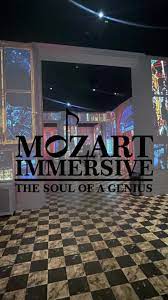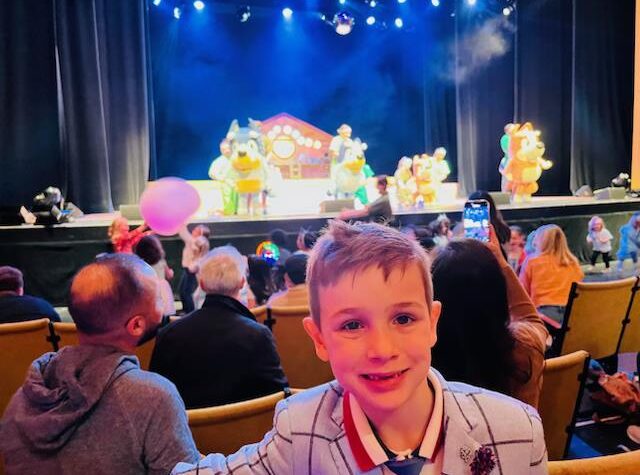
 *** Now playing at the Lighthouse ArtSpace Chicago is the 45-minute “Immersive Mozart: The Soul of a Genius”, which brings the 18th century composer to life via the video enhancement of his music. The sights play second fiddle to the sounds in this exhibition, which loosely tells the story of Mozart’s biography in nine distinct and precisely timed scenes, projected on the walls and floor of several adjacent galleries plus the balcony. The projections are huge, animated, dreamlike, and highly imaginative with many beautiful and unique elements. For example, the ornate furniture and accouterments from Mozart’s time set the tone and add magical realism to the presentation. The cascades of stars and snowflakes are wonderful. The rhythmic repetition of images is expertly done as is the expansion, contraction, and movement of characters and objects in all directions. The imagery that accompanies the performance of Mozart’s works is all perfectly lovely. But considering the sophisticated and amazing computer technology (including A.I.) behind the spectacle, I expected to be wowed. But unfortunately, the aesthetics, the music, and the life story didn’t come together as well as they needed to. Some scenes work better than others; and the exhibition, taken as a whole, could have been more awe-inspiring.
*** Now playing at the Lighthouse ArtSpace Chicago is the 45-minute “Immersive Mozart: The Soul of a Genius”, which brings the 18th century composer to life via the video enhancement of his music. The sights play second fiddle to the sounds in this exhibition, which loosely tells the story of Mozart’s biography in nine distinct and precisely timed scenes, projected on the walls and floor of several adjacent galleries plus the balcony. The projections are huge, animated, dreamlike, and highly imaginative with many beautiful and unique elements. For example, the ornate furniture and accouterments from Mozart’s time set the tone and add magical realism to the presentation. The cascades of stars and snowflakes are wonderful. The rhythmic repetition of images is expertly done as is the expansion, contraction, and movement of characters and objects in all directions. The imagery that accompanies the performance of Mozart’s works is all perfectly lovely. But considering the sophisticated and amazing computer technology (including A.I.) behind the spectacle, I expected to be wowed. But unfortunately, the aesthetics, the music, and the life story didn’t come together as well as they needed to. Some scenes work better than others; and the exhibition, taken as a whole, could have been more awe-inspiring.
While I enjoyed listening to a variety of compositions throughout (including excerpts from “The Magic Flute”, “The Marriage of Figaro”, “Eine Kleine Nachtmusik”, and an array of symphonies, concertos, and sonatas), the largest fault has to do with the venue’s soundscape. In spite of the generous recordings we hear by the Kansas City Symphony Orchestra and Kansas State Chorus, it becomes difficult to pick out the various characteristics of the original works and their rearrangement. While the sound system is powerful enough to fill the space, sound definition has been sacrificed, and the music seems muddied. Considering modern developments in audio technology, the quality of the sound should have been much better.
In Scene Five, we see Mozart’s father Leopold (expertly portrayed by Mikhail Baryshnikov) whose influence on his son is nicely explained in the libretto. But with the room being fairly dark and variably lit, one cannot read the printed text while watching the performance—and one doesn’t really want to view it on a lighted cell phone display since that ruins the mood. Hence it becomes nearly impossible to follow the sequences of Mozart’s personal history until reading about it afterwards or memorizing his story in advance. The result is that there is a certain amount of disconnect between what we read and what we see.
More importantly, Baryshnikov’s presence begs the question of why we don’t see an actor playing Mozart himself. We see him once in awhile portrayed as a cartoon puppet and occasionally as a drawing or caricature, and at other moments, his bust looks rather ghoulish. As with Baryshnikov, an actor ought to depict the composer as a live human being and not just as a myth. He needs to interact with his environment and possibly with other people. I understand why the toy monkey beating the drum was used at the end of the performance so as to analogize his bizarre sense of humor. But had it not been for the man’s genius and the vivacity and daring of his craft, there would no reason to dwell on his quirky and childish behavior. When the cartoon overlays the complete list of Mozart’s musical works, this seems to equate both aspects of his life with each other when there is no reason to do so. And all I could think about was the Energizer Bunny—and the movie “Amadeus”, which included Mozart’s distinct laugh.
I also learned the word “proprioception” today, which means “perception or awareness of the position and movement of the body.” As you stroll the galleries, you need to be mindful about where stairs are located and where mirrors are positioned within each hall. Your orientation or sense of direction could become confused if you become overly absorbed with the images being projected onto the floor and walls. Some people were happier remaining in their seats the entire time (like my guest), whereas I enjoyed strolling the galleries and continually turning myself 360 degrees to see all of the images in the hall that I was visiting as well as adjacent ones. For me, the best part was interacting with the visual effects, including intentionally disorienting myself (such as when I walked in the reverse direction of a spinning dial on the floor) and losing myself in both direction and thought. So while I enjoyed myself in this special way, I’m not sure that this particular presentation was entirely successful in creating a delicate balance among our senses and our sense of history that it sets out to achieve. Above all, I never truly experienced “the soul of a genius”, as the title of the show promises.
Having said that, the aesthetic, auditory, and spatial delights create many instances when there is almost too much going on at once, such that the mind cannot absorb it all at once. This becomes all the more reason to buy tickets and see the show again. More to the point, attending “Mozart Immersive” can be a unique adventure if you wear earplugs inserted just far enough to block out the sounds of other people chatting but not so far as to drown out the subtleties inherent to the way the music ought to be experienced. Once you walk far enough away from those with lit cell phones, then perhaps then you can become better engaged with a parallel universe—full of frivolity and a sense of the past—and in the process, gain a somewhat better appreciation of the man and his undying music.
“Mozart Immersive” is currently playing at the Lighthouse ArtSpace, 108 W. Germania Place, located off Clark Street, in Chicago’s River North area.
Tickets start at $27 and are on sale now at https://mozartimmersive.com/.
For more information, including times and dates of performances, see https://mozartimmersive.com/ or follow @lighthouseartspacechicago on Facebook and Instagram.






More Stories
“The Prom” at Glenbrook High School
“The Simon & Garfunkel Story” comes to Chicago
Passover Dinner at Frank’s ( Italian style)